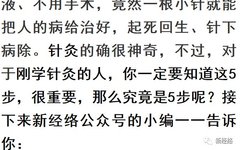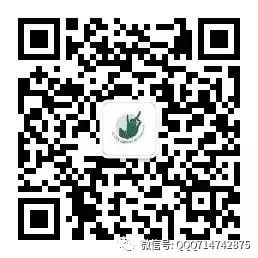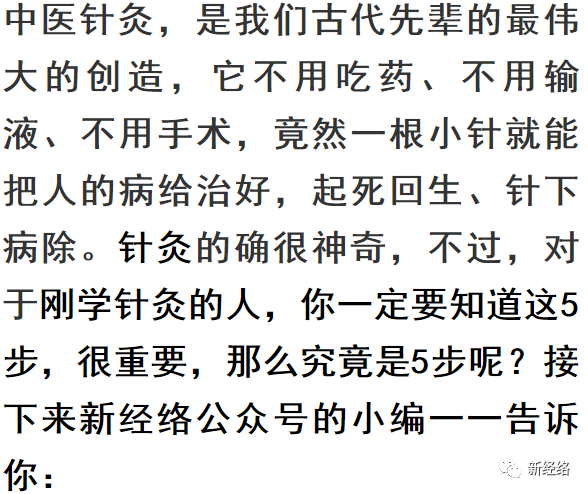
1
Beginning Acupuncture
A small needle may seem insignificant, but when it comes to needling yourself or others, not many can successfully insert it into the body on the first try.
First: When needling yourself, fear of pain makes it hard to commit;
Second: When needling others, lack of skill not only makes it difficult to insert the needle but can also bend it, causing pain for both the patient and the practitioner, further diminishing the courage to needle;
Third: Even if you bravely needle someone or yourself, if either party grimaces in pain, you may manage to needle once, but you will never be allowed to do it a second time!
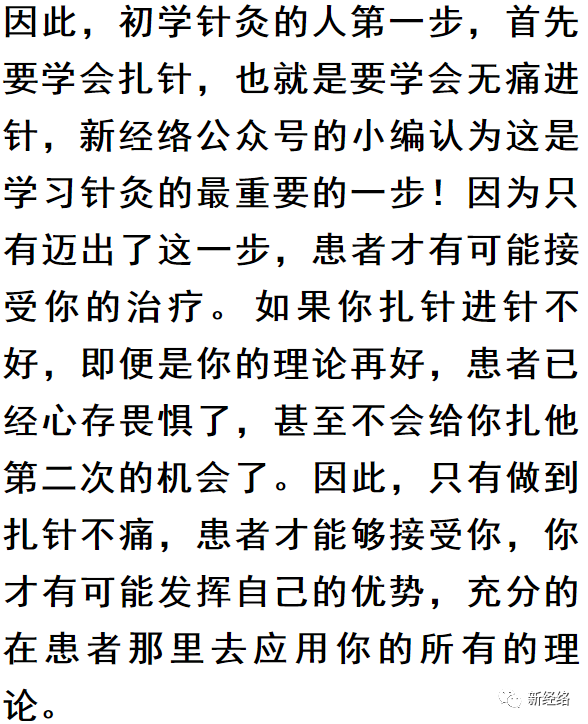
Diagnosis and treatment based on syndrome differentiation leads to the resolution of illness. This is the principle of learning needling before theory. So how can we achieve painless needling?
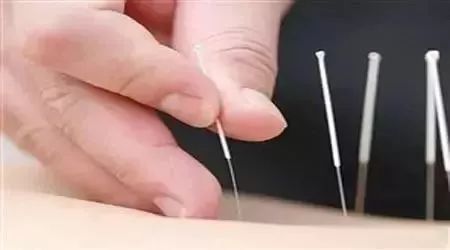
This is actually a simple issue that can be easily resolved, but you must understand the principles behind the pain of needling. To lead a cow, one must grasp its nose; once you understand the principle, you will know how to avoid the pain of needling.
◆ Pain is the sensation produced when the needle pierces a blood vessel.
◆ Soreness is the sensation produced when the needle penetrates muscle.
◆ Numbness is the sensation produced when the needle touches a nerve.
◆ Heaviness is the sensation produced when the needle reaches the periosteum.
Understanding the sensations produced by needling different tissues reveals that pain does not occur everywhere; it only occurs when the needle penetrates a blood vessel.
Therefore, to avoid pain during needling, simply avoid blood vessels.
While larger blood vessels can be avoided, smaller capillaries are not visible and cannot be avoided. What to do?
In fact, much of the pain occurs during the insertion of the needle: Once the needle pierces the skin and enters the muscle layer, pain is rarely felt. Why is this?
As we know, the skin consists of the epidermis and dermis; the epidermis is primarily made of epidermal cells, while the dermis is rich in nerves and capillaries. Therefore, the fundamental cause of pain during needling is the needle piercing through the dermis and hitting capillaries.
Thus, if we can allow the needle tip to quickly penetrate the dermis and enter the muscle layer, we can effectively avoid pain during insertion.
Since the distribution of blood vessels in the muscle layer is sparse, pain is not easily produced. We also know that the thickest part of the skin is about one millimeter; the needle tip is so fine that with a little force, it can quickly penetrate the skin and enter the muscle layer.
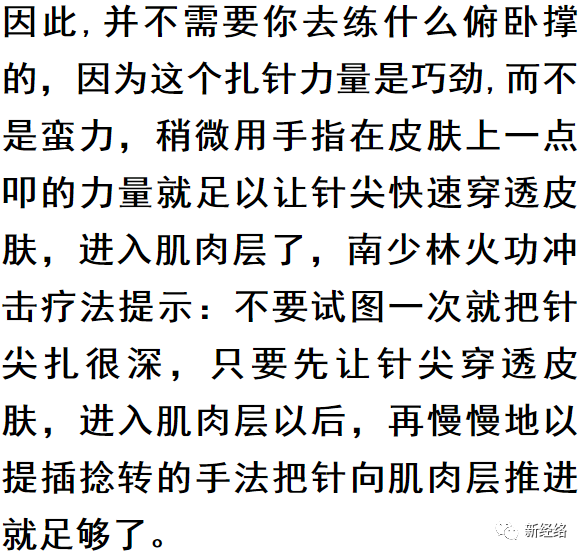

Knowing this, we can understand how to avoid pain during needling, thus achieving the realm of painless needling: hold the needle body or handle with your thumb and index finger, while the middle finger supports the needle tip, effectively hiding the needle tip in the pad of the middle finger. When you quickly press the desired acupuncture point with your middle finger, the needle tip will swiftly penetrate the dermis and enter the muscle layer, allowing the patient to feel no pain while the needle is already in the muscle layer.
Then, slowly twist or gently push the needle deeper into the muscle to produce various sensations of soreness, numbness, heaviness, and swelling, thus achieving the so-called “obtaining qi.” The essence of needling is that when qi arrives, it is effective; the effect is reliable, like the wind blowing clouds, clear as if seen under the blue sky, thus completing the art of needling.
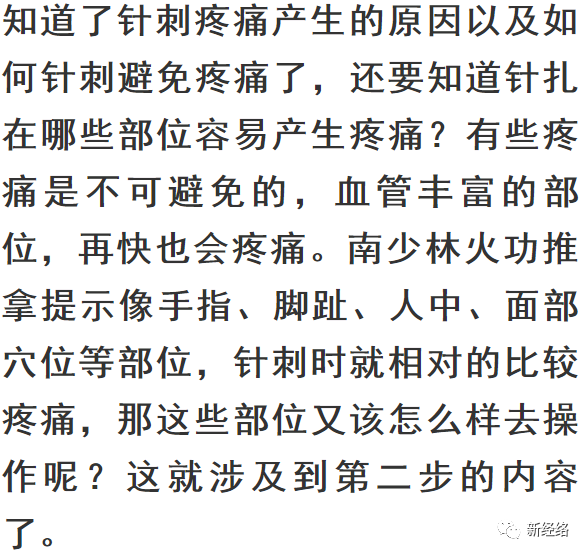
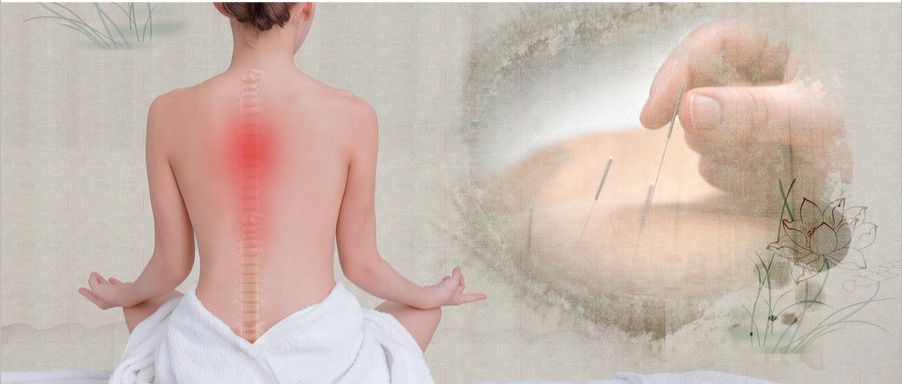
2
Needling Techniques for Various Body Parts
1
Horizontal Needling Technique:
Method: First, position the needle at a 30-45 degree angle to the scalp where needling is to occur, quickly penetrate the needle tip through the scalp to the subaponeurotic layer, then lower the needle body to a parallel position with the scalp, and slowly advance the needle. If there is resistance, it indicates contact with the skull; you can withdraw the needle slightly, lower it further, and then slowly advance again.
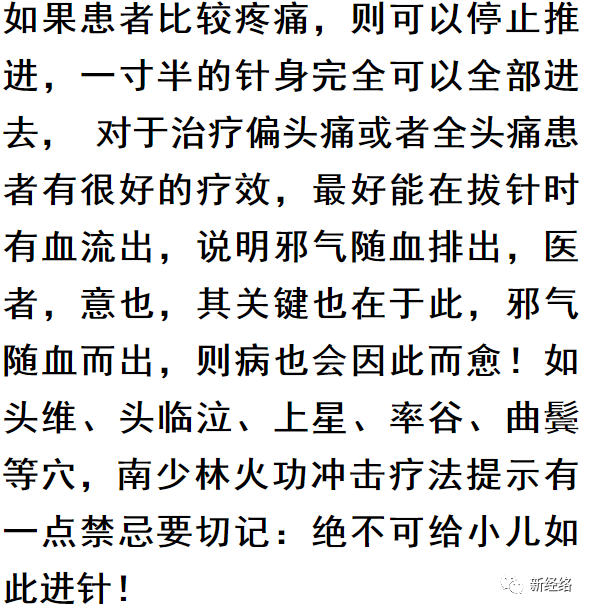
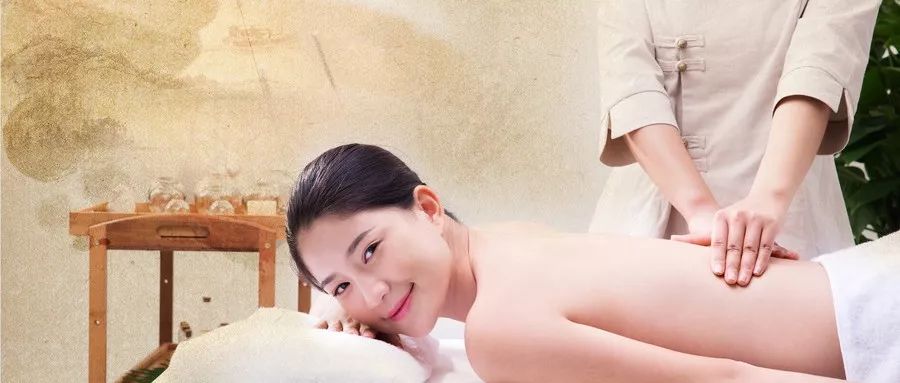
2
Facial Acupuncture Point Insertion Method
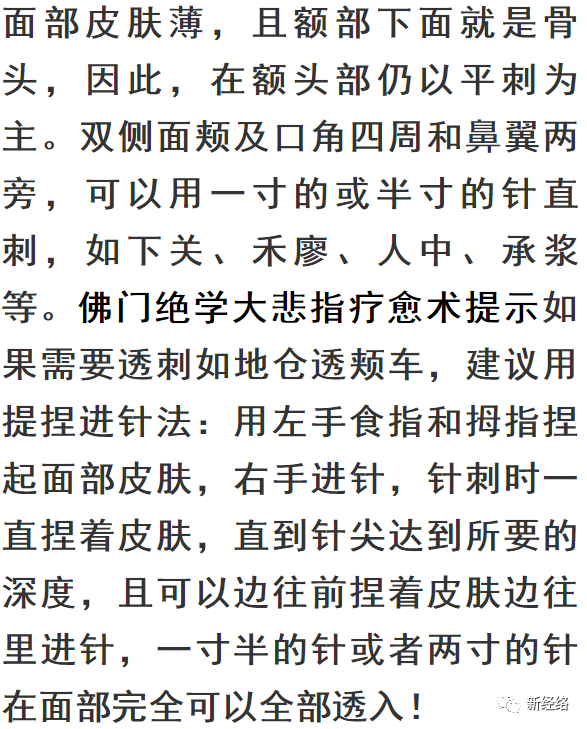
For horizontal needling on the forehead, it is recommended to use the pinch insertion method. When inserting at the Yintang point, I always use the pinch insertion method, which is a very effective way to needle. The WeChat public account “New Meridians” suggests that for needling around the eyes, especially at the Jingming (Bright Eyes) and Qihou (Behind the Eye) points, direct insertion is preferred, using a finer needle. After pressing the eyeball to the side, slowly advance the needle inward, avoiding rapid insertion to prevent eye injury. The needle can be inserted about 1.2 inches.
For needling points on the face, temples, and around the eyes, the key is withdrawing the needle: this is the only key to avoiding bruising and facial bleeding. It is essential to apply pressure for at least one minute after withdrawing the needle, ensuring effective pressure rather than just a superficial application. This prevents internal bleeding and bruising, which can affect aesthetics and the patient’s willingness to continue treatment. Remember this!
3
Neck and Nape
I rarely select acupuncture points in the neck; even when I do, I use half-inch small needles for direct insertion. This is somewhat conservative, but as the saying goes, one who walks by the river should not get their shoes wet. Safety is the top priority. I once had a teacher skilled at needling the Yingxiang point, but I still prioritize safety and rarely select it, so I have little constructive advice on this matter. I hope to learn more from my peers!
4
Back of the Neck
This area is primarily used to treat cervical spondylosis, but it is crucial to master the direction of needling, inserting diagonally towards the spine, about one and a half inches deep (depending on the patient’s body type). When withdrawing the needle, be sure to apply pressure to the acupuncture point to prevent subcutaneous bleeding and swelling! For points like Fengfu (Wind Mansion) and Yamen (Mute Gate), safety is paramount; if the needle lacks a firm grip, it is best to avoid deep needling and proceed cautiously.
As for using a three-inch needle to deeply needle towards the throat for treating swallowing difficulties due to pharyngeal nerve paralysis, if the needle lacks a firm grip, it is advisable to avoid attempting this. It is best to understand the anatomy clearly before trying; otherwise, the consequences are yours to bear.
5
Back
The abdomen is deep as a well, while the back is thin as a pancake! For the Jiaji points on the chest and lumbar region, deeper needling is acceptable, but it must be angled towards the spine. It is important to gauge the depth; if the patient feels pain or discomfort, stop immediately and withdraw slightly. This avoids unexpected situations. This technique has shown remarkable efficacy in improving the function of thoracic and abdominal organs, and the WeChat public account “New Meridians” suggests that for Taiyang (Sun) points, direct needling is acceptable, but deep needling is not recommended. Depending on the patient’s body type, half-inch small needles can be used for direct insertion, but deeper needling should be approached with caution.
6
Abdomen
The abdomen is deep as a well, but in the liver and gallbladder area, one should be cautious and avoid deep needling! Additionally, if needling the lower abdomen, it is best to have the patient urinate before treatment! Attention to detail is crucial; sometimes, details determine success or failure. Given the poor medical environment in the country, caution is paramount.
7
Acupuncture Points on the Limbs
Various needling techniques can be freely applied to the limbs, as there are no organ interferences. The Southern Shaolin Fire Kung Fu Massage suggests that for those with a solid foundation in acupuncture knowledge, selecting points on the limbs can sometimes yield miraculous effects: for example, the selection and application of the Five Transporting Points and Eight Extraordinary Vessels. In fact, selecting limb points to treat diseases is the best way to judge the skill level of an acupuncturist. Regulating organ function and qi and blood flow through limb point selection is the hallmark of a true expert.
For the distal ends of the limbs and the palms and soles, it is recommended to use half-inch or one-inch small needles, quickly puncturing in; it will hurt just that moment, so be decisive, otherwise, the patient will be in unbearable pain. Remember!
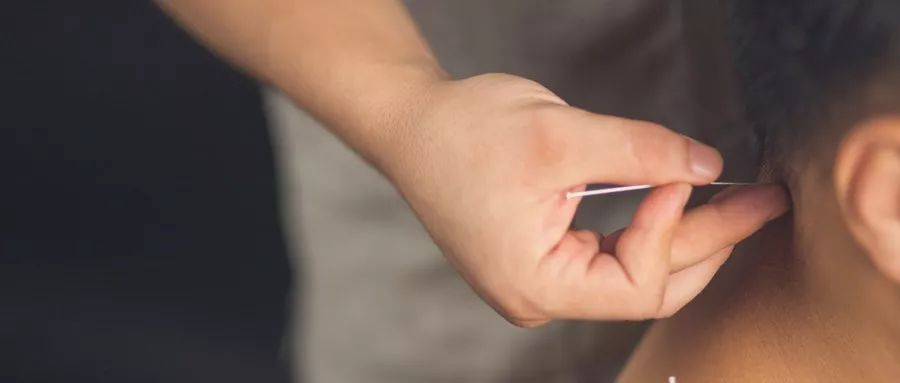
If the patient is too tense, causing muscle contraction and making needling difficult, you can use a roundabout approach, distracting the patient’s attention. Apply pressure with your left hand on the opposite side of the needling area, allowing the muscle at the needling site to relax completely, then quickly insert the needle. This can effectively avoid pain.
Now that the needle can be inserted and the patient is accepting it, what should we do next? Perhaps you have forgotten that while you are learning how to needle, you have yet to study the theory of Traditional Chinese Medicine!
So the next step is to diligently study acupuncture theory to provide a strong theoretical basis for your skills. This is essential; we cannot just be needle workers; we must be acupuncturists.
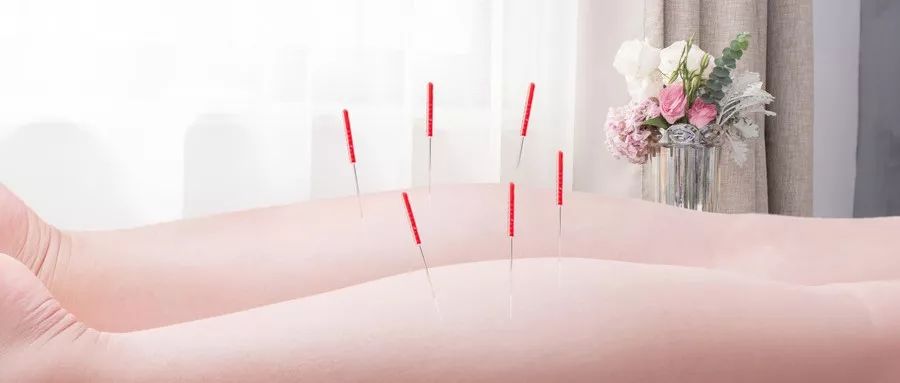
3
Study Traditional Chinese Medicine Acupuncture Theory Diligently
First: You must know which diseases are suitable for acupuncture treatment. This is quite critical. As stated in the “Neijing”: “When the five organs are diseased, it is like a needle; it is like dirt; it is like a knot; it is like a closure. Although a needle can be pulled out after a long time, dirt can be cleared, knots can be untied, and closures can be opened. Some say that chronic diseases cannot be treated; this is not true. A skilled acupuncturist can treat diseases as one would pull out a needle, clear dirt, untie knots, and open closures. Even chronic diseases can be resolved. Those who say they cannot be treated have not mastered the technique.”
It seems that almost any illness can be regulated, but the reason we cannot regulate it is that we have not truly mastered the methods to do so. However, for painful diseases and internal diseases, including movement disorders caused by neurological conditions, acupuncture remains the first choice for treatment.
Second: Syndrome differentiation and treatment is always the fundamental principle guiding clinical practice in Traditional Chinese Medicine. This applies to herbal formulas as well as acupuncture. Mastering the foundational theories of Traditional Chinese Medicine, including the four diagnostic methods of observation, listening, inquiry, and palpation, is essential to determine the patient’s yin-yang balance, exterior-interior condition, cold-heat, and deficiency-excess, thus guiding the use of needles and herbs. This may be challenging for non-professionals, but it is necessary to know.
Third: You must be thoroughly familiar with the pathways of the twelve meridians and the eight extraordinary vessels. Additionally, you should be well-versed in the original descriptions of the diseases associated with the twelve meridians. This is the most basic requirement. Without knowing the pathways of the meridians, it is impossible to become a good acupuncturist.
Fourth: Each acupuncture point has its significance; you should understand the origins of each point’s name. Although some may seem forced, it is still advisable to look at various interpretations, as they can inspire thoughts on acupuncture treatment. For example, points like Tianshu (Heavenly Pivot), Tiantu (Heavenly Tidal), Xiongxiang (Chest Village), Yunmen (Cloud Gate), Guanyuan (Gate of Origin), and Yinbai (Hidden White) all provide hints for treating diseases.
Fifth: Understand the uses and meanings of the Five Transporting Points and Eight Extraordinary Vessels, such as the Jing point governing fullness under the heart, the Ying point governing body heat, the Shu point governing heavy joint pain, the Jing point governing cough and cold, and the He point governing counterflow qi and leakage. These are all experiences passed down from our ancestors, which we can fully verify in clinical practice.
Once you understand these theories, you can apply and verify them in clinical practice, enjoying the gradual accumulation of knowledge and the recognition from patients, leading to a sense of pride in your profession. But this is just the beginning; greater challenges lie ahead…
4
Improve through Practice, Practice through Improvement
By the third step, you can basically address common and frequently occurring diseases, bringing a certain level of professional satisfaction and experiencing the unprecedented sense of achievement and fulfillment that acupuncture can provide, while also allowing for some financial gain.
However, our journey is still long; our knowledge is merely superficial, and there is much more knowledge and theory to explore and verify to enhance the efficacy of our needling.
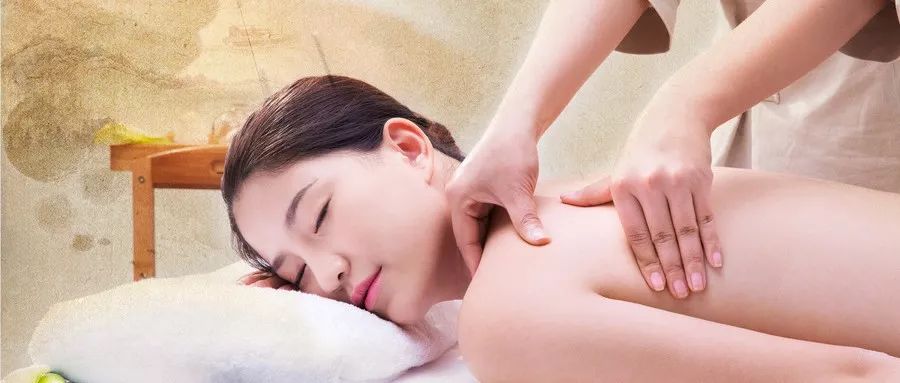
5
Unity of Needle and Person
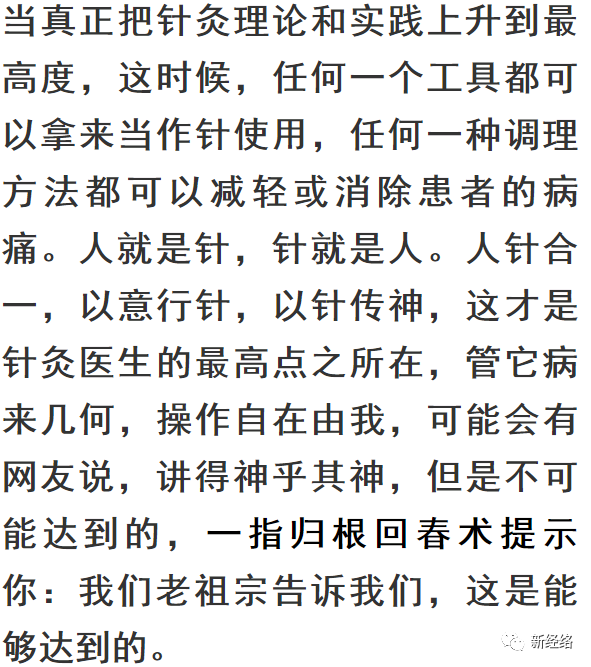
The reason we do not achieve this is that our efforts or wisdom are still insufficient. What do you think?
Recommended Previous Articles:
1. If you have insomnia, press here and lie down to sleep (with video)
2. All diseases that cannot be cured are the result of interrupted meridians! (with solutions)
3. The best way to restore vitality: tonify qi (in-depth article!)
4. Five minutes to see results, a very effective cough point on the hand
5. Rhinitis is not difficult to treat; one finger can solve it!
Exciting content continues tomorrow…
The first is “New Meridians” |
This public account will help you quickly master various practical and easy-to-use Traditional Chinese Medicine health care techniques.
|
The second is “Subconscious Acupoint”“ This public account mainly helps you decode the various mysteries of the “subconscious”; anyone who understands the wonders of the “subconscious” can make their life smooth sailing… |
|
The third is “Head Edition Health” |
Making an appointment with an expert can only treat one patient, while a good medical or health article can benefit thousands; that is what “Head Edition Health” aims to do.
|
There are two methods: 1. Long press the QR code image below, then click “Recognize the QR code in the image,” and finally click “Follow” to add.
(“New Meridians” QR code image)
“Subconscious Acupoint” QR code image

“Head Edition Health” QR code image
 2. Open the QR code scanner on WeChat and point it at the image above to follow.
2. Open the QR code scanner on WeChat and point it at the image above to follow.

